A research for using bazan soil as filling materials of homogeneous earth dams in Tay Nguyen area
Using local soil as filling material for homogeneous earth dams could reduce
remarkably construction cost. However, the Bazan soil in Tay Nguyen area has strong
absorbability and quick disintegration with water. Those properties bring about the difficulty
for construction process and could be the reason for the high number of the earth dam
accidents in this area in the country. The paper investigates the physical characteristics and
mechanical behaviors of Bazan soil. Based on that, proposes the approach for quality
improvement and design criterion when using Bazan soil for homogeneous earth dams. The
result of experiments reveals that Bazan soil has low dry density and high optimum moisture
content, which is the cause of difficulty in the construction phase. Whereas, if suppling 10-
12% of mixture weight by using grit, the mechanical properties of mixture is going to be
improved significantly and can be used for filling the embankment dam.
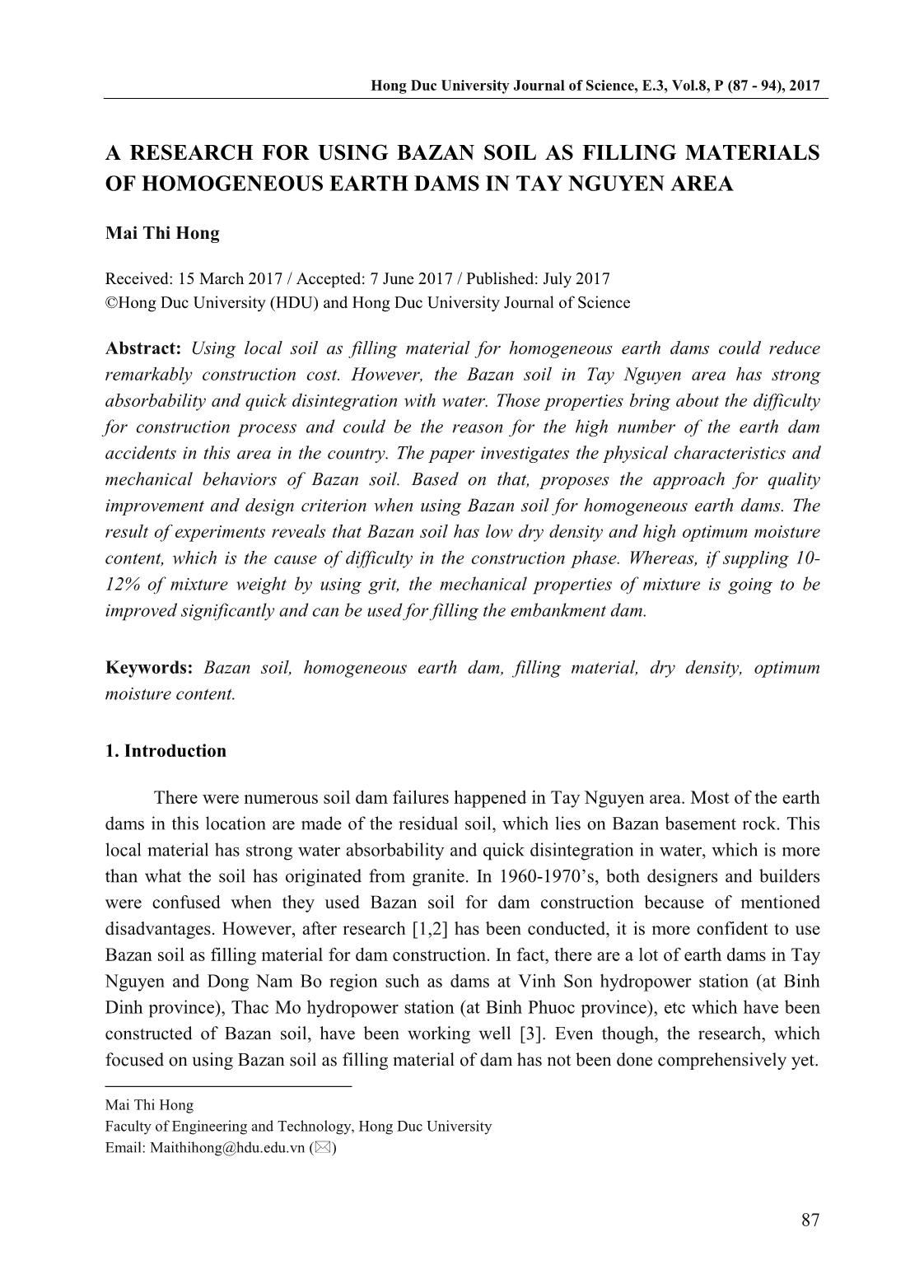
Trang 1
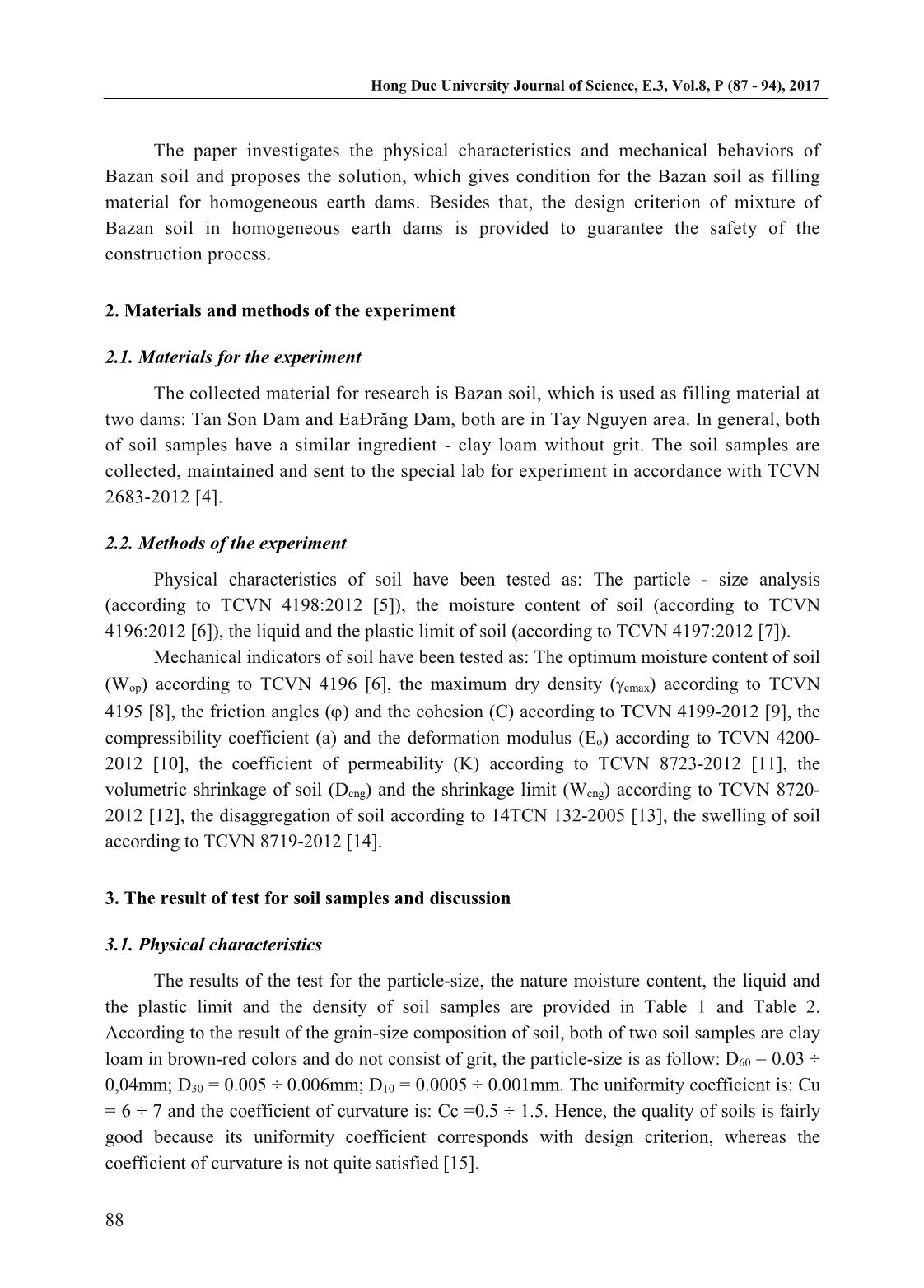
Trang 2
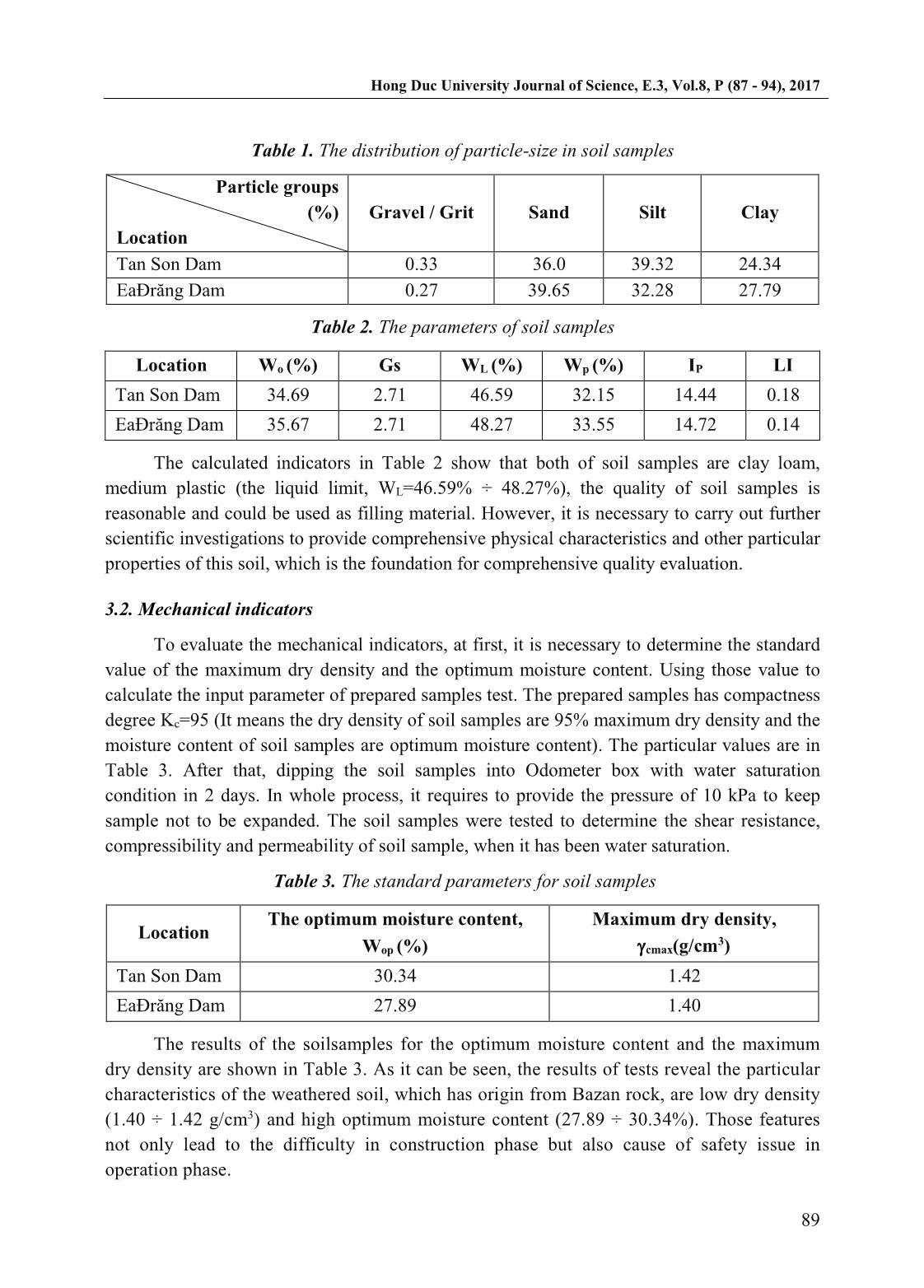
Trang 3
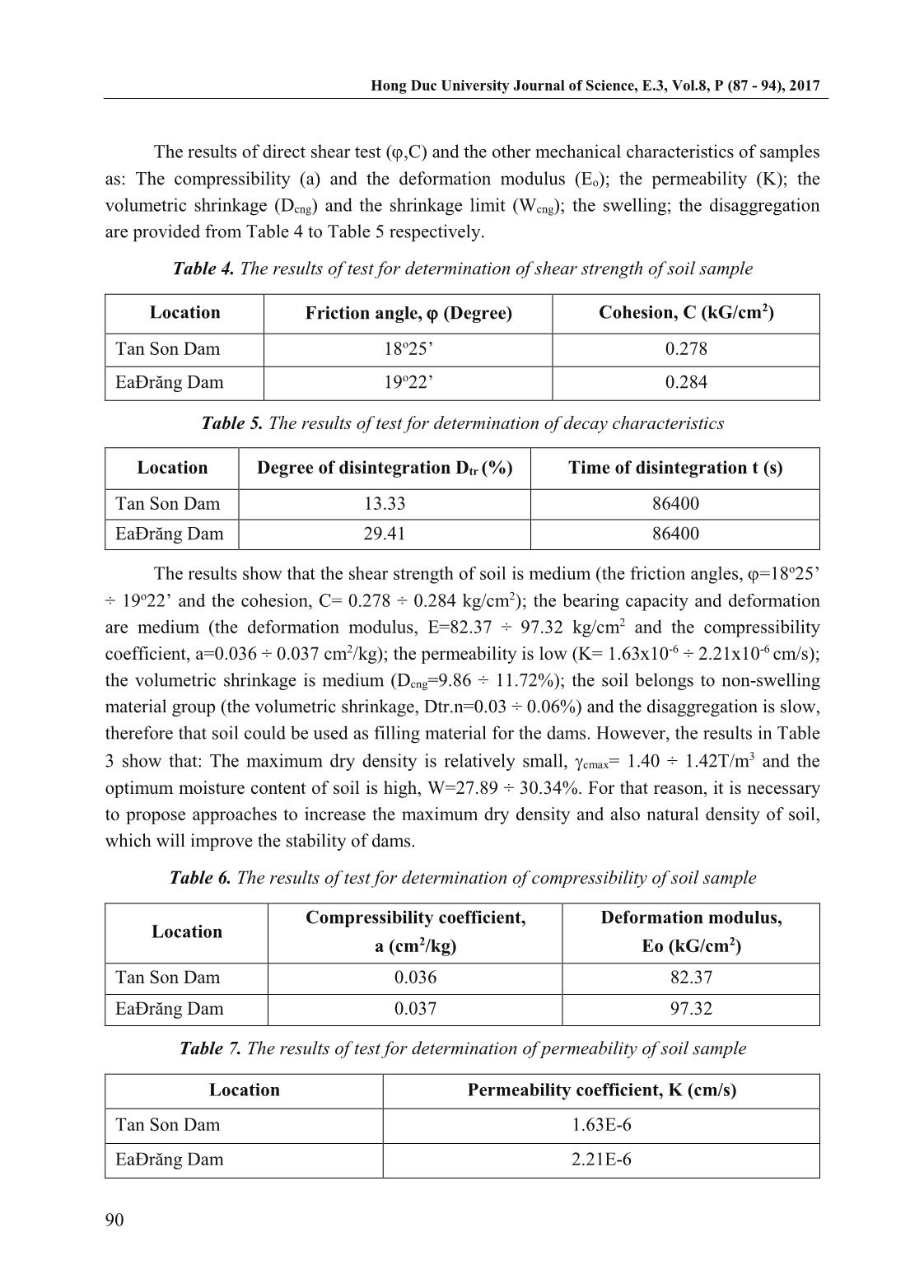
Trang 4
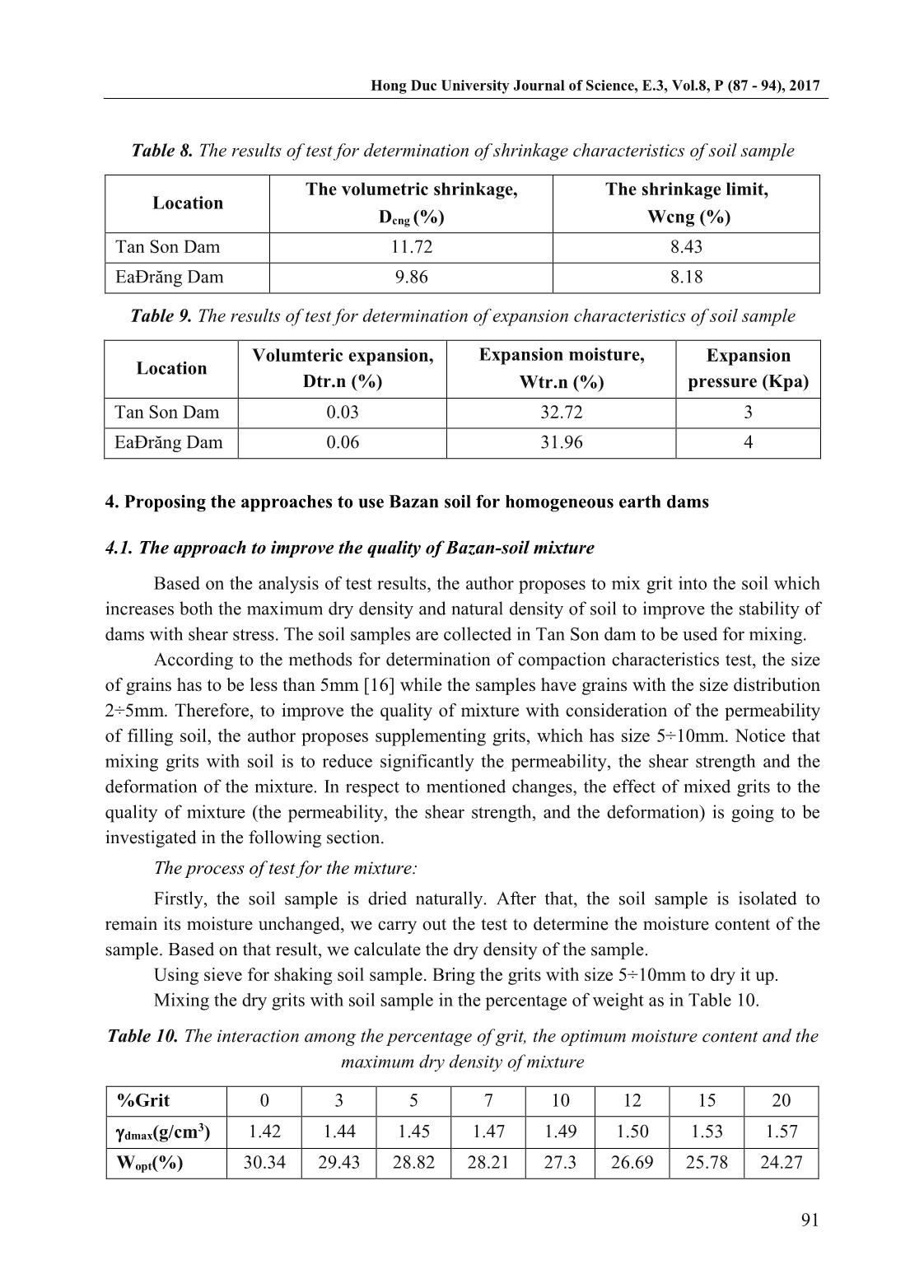
Trang 5
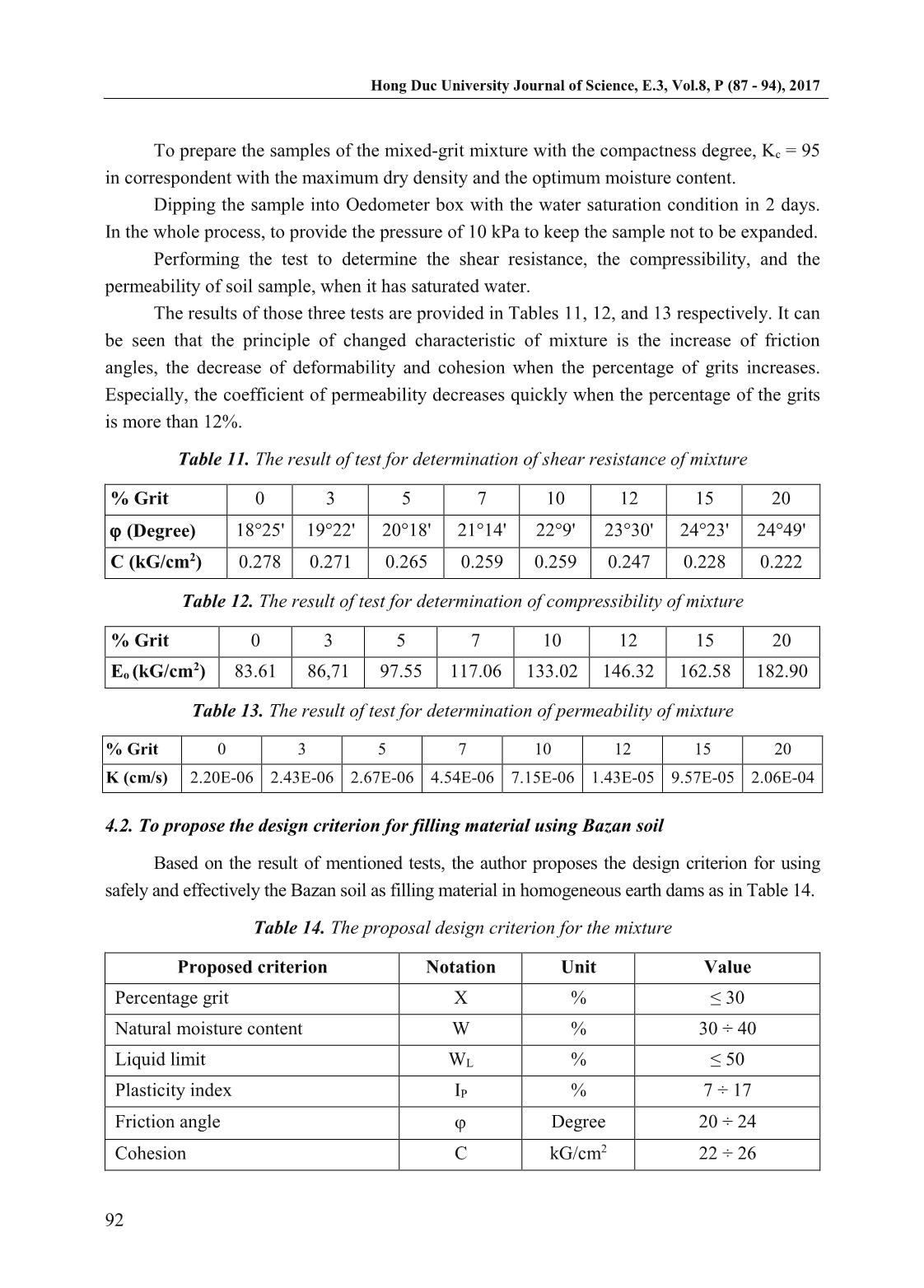
Trang 6
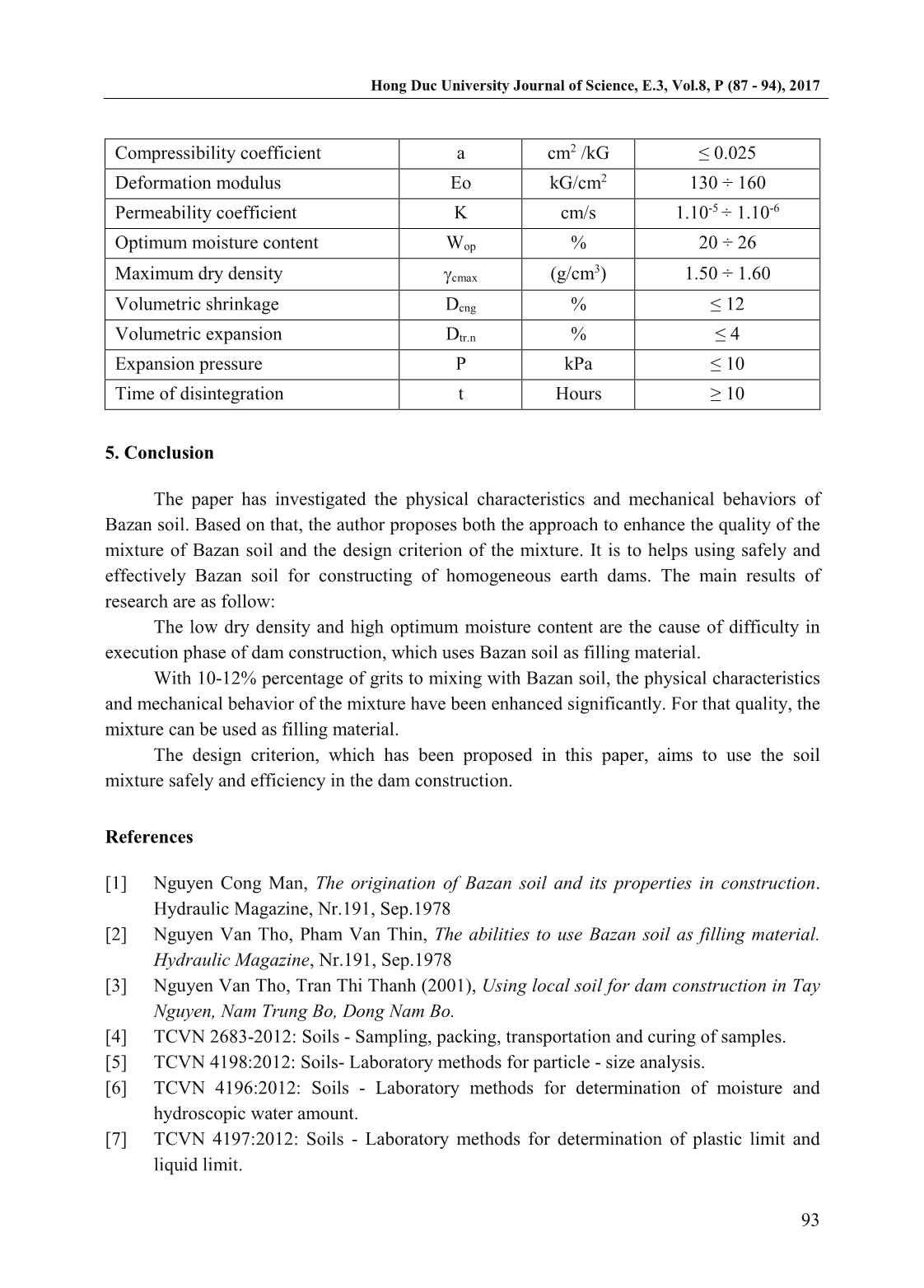
Trang 7
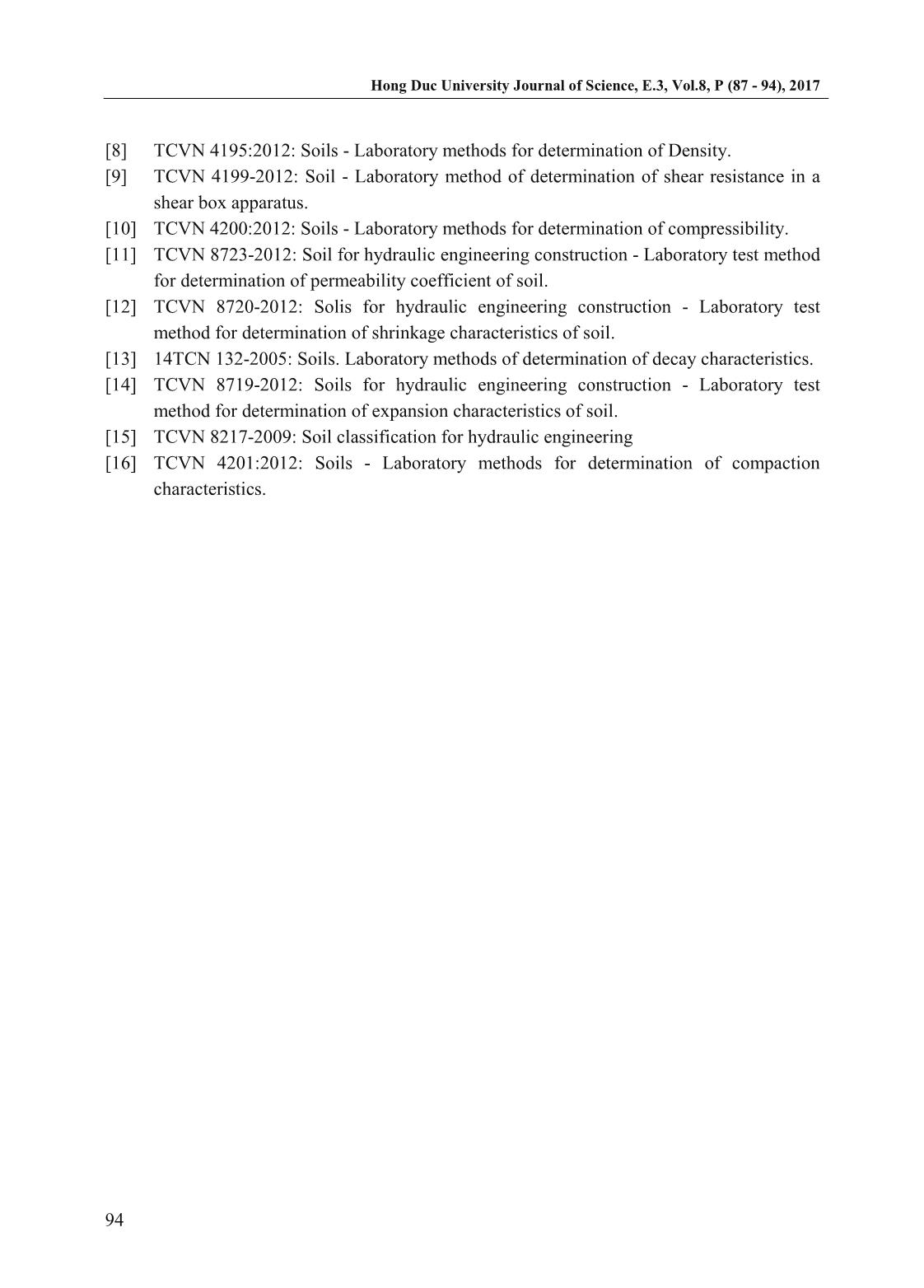
Trang 8
Tóm tắt nội dung tài liệu: A research for using bazan soil as filling materials of homogeneous earth dams in Tay Nguyen area
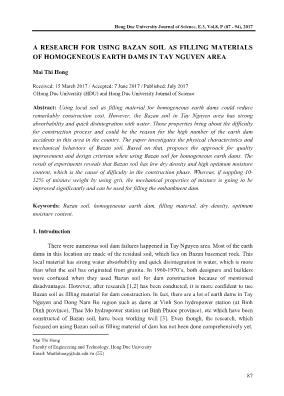
Hong Duc University Journal of Science, E.3, Vol.8, P (87 - 94), 2017 87 A RESEARCH FOR USING BAZAN SOIL AS FILLING MATERIALS OF HOMOGENEOUS EARTH DAMS IN TAY NGUYEN AREA Mai Thi Hong1 Received: 15 March 2017 / Accepted: 7 June 2017 / Published: July 2017 ©Hong Duc University (HDU) and Hong Duc University Journal of Science Abstract: Using local soil as filling material for homogeneous earth dams could reduce remarkably construction cost. However, the Bazan soil in Tay Nguyen area has strong absorbability and quick disintegration with water. Those properties bring about the difficulty for construction process and could be the reason for the high number of the earth dam accidents in this area in the country. The paper investigates the physical characteristics and mechanical behaviors of Bazan soil. Based on that, proposes the approach for quality improvement and design criterion when using Bazan soil for homogeneous earth dams. The result of experiments reveals that Bazan soil has low dry density and high optimum moisture content, which is the cause of difficulty in the construction phase. Whereas, if suppling 10- 12% of mixture weight by using grit, the mechanical properties of mixture is going to be improved significantly and can be used for filling the embankment dam. Keywords: Bazan soil, homogeneous earth dam, filling material, dry density, optimum moisture content. 1. Introduction There were numerous soil dam failures happened in Tay Nguyen area. Most of the earth dams in this location are made of the residual soil, which lies on Bazan basement rock. This local material has strong water absorbability and quick disintegration in water, which is more than what the soil has originated from granite. In 1960-1970’s, both designers and builders were confused when they used Bazan soil for dam construction because of mentioned disadvantages. However, after research [1,2] has been conducted, it is more confident to use Bazan soil as filling material for dam construction. In fact, there are a lot of earth dams in Tay Nguyen and Dong Nam Bo region such as dams at Vinh Son hydropower station (at Binh Dinh province), Thac Mo hydropower station (at Binh Phuoc province), etc which have been constructed of Bazan soil, have been working well [3]. Even though, the research, which focused on using Bazan soil as filling material of dam has not been done comprehensively yet. Mai Thi Hong Faculty of Engineering and Technology, Hong Duc University Email: Maithihong@hdu.edu.vn ( ) Hong Duc University Journal of Science, E.3, Vol.8, P (87 - 94), 2017 88 The paper investigates the physical characteristics and mechanical behaviors of Bazan soil and proposes the solution, which gives condition for the Bazan soil as filling material for homogeneous earth dams. Besides that, the design criterion of mixture of Bazan soil in homogeneous earth dams is provided to guarantee the safety of the construction process. 2. Materials and methods of the experiment 2.1. Materials for the experiment The collected material for research is Bazan soil, which is used as filling material at two dams: Tan Son Dam and EaĐrăng Dam, both are in Tay Nguyen area. In general, both of soil samples have a similar ingredient - clay loam without grit. The soil samples are collected, maintained and sent to the special lab for experiment in accordance with TCVN 2683-2012 [4]. 2.2. Methods of the experiment Physical characteristics of soil have been tested as: The particle - size analysis (according to TCVN 4198:2012 [5]), the moisture content of soil (according to TCVN 4196:2012 [6]), the liquid and the plastic limit of soil (according to TCVN 4197:2012 [7]). Mechanical indicators of soil have been tested as: The optimum moisture content of soil (Wop) according to TCVN 4196 [6], the maximum dry density (cmax) according to TCVN 4195 [8], the friction angles ( ) and the cohesion (C) according to TCVN 4199-2012 [9], the compressibility coefficient (a) and the deformation modulus (Eo) according to TCVN 4200- 2012 [10], the coefficient of permeability (K) according to TCVN 8723-2012 [11], the volumetric shrinkage of soil (Dcng) and the shrinkage limit (Wcng) according to TCVN 8720- 2012 [12], the disaggregation of soil according to 14TCN 132-2005 [13], the swelling of soil according to TCVN 8719-2012 [14]. 3. The result of test for soil samples and discussion 3.1. Physical characteristics The results of the test for the particle-size, the nature moisture content, the liquid and the plastic limit and the density of soil samples are provided in Table 1 and Table 2. According to the result of the grain-size composition of soil, both of two soil samples are clay loam in brown-red colors and do not consist of grit, the particle-size is as follow: D60 = 0.03 ÷ 0,04mm; D30 = 0.005 ÷ 0.006mm; D10 = 0.0005 ÷ 0.001mm. The uniformity coefficient is: Cu = 6 ÷ 7 and the coefficient of curvature is: Cc =0.5 ÷ 1.5. Hence, the quality of soils is fairly good because its uniformity coefficient corresponds with design criterion, whereas the coefficient of curvature is not quite satisfied [15]. Hong Duc University Journal of Science, E.3, Vol.8, P (87 - 94), 2017 89 Table 1. The distribution of particle-size in soil samples Particle groups (%) Location Gravel / Grit Sand Silt Clay Tan Son Dam 0.33 36.0 39.32 24.34 EaĐrăng Dam 0.27 39.65 32.28 27.79 Table 2. The parameters of soil samples Location Wo (%) Gs WL (%) Wp (%) IP LI Tan Son Dam 34.69 2.71 46.59 32.15 14.44 0.18 EaĐrăng Dam 35.67 2.71 48.27 33.55 14.72 0.14 The calculated indicators in Table 2 show that both of soil samples are clay loam, medium plastic (the liquid limit, WL=46.59% ÷ 48.27%), the quality of soil samples is reasonable and could be used as filling material. However, it is necessary to carry out further scientific investigations to provide comprehensive physical characteristics and other particular properties of this soil, which is the foundation for comprehensive quality evaluation. 3.2. Mechanical indicators To evaluate the mechanical indicators, at first, it is necessary to determine the standard value of the maximum dry density and the optimum moisture content. Using those value to calculate the input parameter of prepared samples test. The prepared samples has compactness degree Kc=95 (It means the dry density of soil samples are 95% maximum dry density and the moisture content of soil samples are optimum moisture content). The particular values are in Table 3. After that, dipping the soil samples into Odometer box with water saturation condition in 2 days. In whole process, it requires to provide the pressure of 10 kPa to keep sample not to be expanded. The soil samples were tested to determine the shear resistance, compressibility and permeability of soil sample, when it has been water saturation. Table 3. The standard parameters for soil samples Location The optimum moisture content, Wop (%) Maximum dry density, cmax(g/cm3) Tan Son Dam 30.34 1.42 EaĐrăng Dam 27.89 1.40 The results of the soilsamples for the optimum moisture content and the maximum dry density are shown in Table 3. As it can be seen, the results of tests reveal the particular characteristics of the weathered soil, which has origin from Bazan rock, are low dry density (1.40 ÷ 1.42 g/cm3) and high optimum moisture content (27.89 ÷ 30.34%). Those features not only lead to the difficulty in construction phase but also cause of safety issue in operation phase. Hong Duc University Journal of Science, E.3, Vol.8, P (87 - 94), 2017 90 The results of direct shear test ( ,C) and the other mechanical characteristics of samples as: The compressibility (a) and the deformation modulus (Eo); the permeability (K); the volumetric shrinkage (Dcng) and the shrinkage limit (Wcng); the swelling; the disaggregation are provided from Table 4 to Table 5 respectively. Table 4. The results of test for determination of shear strength of soil sample Location Friction angle, (Degree) Cohesion, C (kG/cm2) Tan Son Dam 18o25’ 0.278 EaĐrăng Dam 19o22’ 0.284 Table 5. The results of test for determination of decay characteristics Location Degree of disintegration Dtr (%) Time of disintegration t (s) Tan Son Dam 13.33 86400 EaĐrăng Dam 29.41 86400 The results show that the shear strength of soil is medium (the friction angles, =18o25’ ÷ 19o22’ and the cohesion, C= 0.278 ÷ 0.284 kg/cm2); the bearing capacity and deformation are medium (the deformation modulus, E=82.37 ÷ 97.32 kg/cm2 and the compressibility coefficient, a=0.036 ÷ 0.037 cm2/kg); the permeability is low (K= 1.63x10-6 ÷ 2.21x10-6 cm/s); the volumetric shrinkage is medium (Dcng=9.86 ÷ 11.72%); the soil belongs to non-swelling material group (the volumetric shrinkage, Dtr.n=0.03 ÷ 0.06%) and the disaggregation is slow, therefore that soil could be used as filling material for the dams. However, the results in Table 3 show that: The maximum dry density is relatively small, cmax= 1.40 ÷ 1.42T/m3 and the optimum moisture content of soil is high, W=27.89 ÷ 30.34%. For that reason, it is necessary to propose approaches to increase the maximum dry density and also natural density of soil, which will improve the stability of dams. Table 6. The results of test for determination of compressibility of soil sample Location Compressibility coefficient, a (cm2/kg) Deformation modulus, Eo (kG/cm2) Tan Son Dam 0.036 82.37 EaĐrăng Dam 0.037 97.32 Table 7. The results of test for determination of permeability of soil sample Location Permeability coefficient, K (cm/s) Tan Son Dam 1.63E-6 EaĐrăng Dam 2.21E-6 Hong Duc University Journal of Science, E.3, Vol.8, P (87 - 94), 2017 91 Table 8. The results of test for determination of shrinkage characteristics of soil sample Location The volumetric shrinkage, Dcng (%) The shrinkage limit, Wcng (%) Tan Son Dam 11.72 8.43 EaĐrăng Dam 9.86 8.18 Table 9. The results of test for determination of expansion characteristics of soil sample Location Volumteric expansion, Dtr.n (%) Expansion moisture, Wtr.n (%) Expansion pressure (Kpa) Tan Son Dam 0.03 32.72 3 EaĐrăng Dam 0.06 31.96 4 4. Proposing the approaches to use Bazan soil for homogeneous earth dams 4.1. The approach to improve the quality of Bazan-soil mixture Based on the analysis of test results, the author proposes to mix grit into the soil which increases both the maximum dry density and natural density of soil to improve the stability of dams with shear stress. The soil samples are collected in Tan Son dam to be used for mixing. According to the methods for determination of compaction characteristics test, the size of grains has to be less than 5mm [16] while the samples have grains with the size distribution 2÷5mm. Therefore, to improve the quality of mixture with consideration of the permeability of filling soil, the author proposes supplementing grits, which has size 5÷10mm. Notice that mixing grits with soil is to reduce significantly the permeability, the shear strength and the deformation of the mixture. In respect to mentioned changes, the effect of mixed grits to the quality of mixture (the permeability, the shear strength, and the deformation) is going to be investigated in the following section. The process of test for the mixture: Firstly, the soil sample is dried naturally. After that, the soil sample is isolated to remain its moisture unchanged, we carry out the test to determine the moisture content of the sample. Based on that result, we calculate the dry density of the sample. Using sieve for shaking soil sample. Bring the grits with size 5÷10mm to dry it up. Mixing the dry grits with soil sample in the percentage of weight as in Table 10. Table 10. The interaction among the percentage of grit, the optimum moisture content and the maximum dry density of mixture %Grit 0 3 5 7 10 12 15 20 dmax(g/cm3) 1.42 1.44 1.45 1.47 1.49 1.50 1.53 1.57 Wopt(%) 30.34 29.43 28.82 28.21 27.3 26.69 25.78 24.27 Hong Duc University Journal of Science, E.3, Vol.8, P (87 - 94), 2017 92 To prepare the samples of the mixed-grit mixture with the compactness degree, Kc = 95 in correspondent with the maximum dry density and the optimum moisture content. Dipping the sample into Oedometer box with the water saturation condition in 2 days. In the whole process, to provide the pressure of 10 kPa to keep the sample not to be expanded. Performing the test to determine the shear resistance, the compressibility, and the permeability of soil sample, when it has saturated water. The results of those three tests are provided in Tables 11, 12, and 13 respectively. It can be seen that the principle of changed characteristic of mixture is the increase of friction angles, the decrease of deformability and cohesion when the percentage of grits increases. Especially, the coefficient of permeability decreases quickly when the percentage of the grits is more than 12%. Table 11. The result of test for determination of shear resistance of mixture % Grit 0 3 5 7 10 12 15 20 (Degree) 18°25' 19°22' 20°18' 21°14' 22°9' 23°30' 24°23' 24°49' C (kG/cm2) 0.278 0.271 0.265 0.259 0.259 0.247 0.228 0.222 Table 12. The result of test for determination of compressibility of mixture % Grit 0 3 5 7 10 12 15 20 Eo (kG/cm2) 83.61 86,71 97.55 117.06 133.02 146.32 162.58 182.90 Table 13. The result of test for determination of permeability of mixture % Grit 0 3 5 7 10 12 15 20 K (cm/s) 2.20E-06 2.43E-06 2.67E-06 4.54E-06 7.15E-06 1.43E-05 9.57E-05 2.06E-04 4.2. To propose the design criterion for filling material using Bazan soil Based on the result of mentioned tests, the author proposes the design criterion for using safely and effectively the Bazan soil as filling material in homogeneous earth dams as in Table 14. Table 14. The proposal design criterion for the mixture Proposed criterion Notation Unit Value Percentage grit X % ≤ 30 Natural moisture content W % 30 ÷ 40 Liquid limit WL % ≤ 50 Plasticity index IP % 7 ÷ 17 Friction angle Degree 20 ÷ 24 Cohesion C kG/cm2 22 ÷ 26 Hong Duc University Journal of Science, E.3, Vol.8, P (87 - 94), 2017 93 Compressibility coefficient a cm2 /kG ≤ 0.025 Deformation modulus Eo kG/cm2 130 ÷ 160 Permeability coefficient K cm/s 1.10-5 ÷ 1.10-6 Optimum moisture content Wop % 20 ÷ 26 Maximum dry density cmax (g/cm3) 1.50 ÷ 1.60 Volumetric shrinkage Dcng % ≤ 12 Volumetric expansion Dtr.n % ≤ 4 Expansion pressure P kPa ≤ 10 Time of disintegration t Hours ≥ 10 5. Conclusion The paper has investigated the physical characteristics and mechanical behaviors of Bazan soil. Based on that, the author proposes both the approach to enhance the quality of the mixture of Bazan soil and the design criterion of the mixture. It is to helps using safely and effectively Bazan soil for constructing of homogeneous earth dams. The main results of research are as follow: The low dry density and high optimum moisture content are the cause of difficulty in execution phase of dam construction, which uses Bazan soil as filling material. With 10-12% percentage of grits to mixing with Bazan soil, the physical characteristics and mechanical behavior of the mixture have been enhanced significantly. For that quality, the mixture can be used as filling material. The design criterion, which has been proposed in this paper, aims to use the soil mixture safely and efficiency in the dam construction. References [1] Nguyen Cong Man, The origination of Bazan soil and its properties in construction. Hydraulic Magazine, Nr.191, Sep.1978 [2] Nguyen Van Tho, Pham Van Thin, The abilities to use Bazan soil as filling material. Hydraulic Magazine, Nr.191, Sep.1978 [3] Nguyen Van Tho, Tran Thi Thanh (2001), Using local soil for dam construction in Tay Nguyen, Nam Trung Bo, Dong Nam Bo. [4] TCVN 2683-2012: Soils - Sampling, packing, transportation and curing of samples. [5] TCVN 4198:2012: Soils- Laboratory methods for particle - size analysis. [6] TCVN 4196:2012: Soils - Laboratory methods for determination of moisture and hydroscopic water amount. [7] TCVN 4197:2012: Soils - Laboratory methods for determination of plastic limit and liquid limit. Hong Duc University Journal of Science, E.3, Vol.8, P (87 - 94), 2017 94 [8] TCVN 4195:2012: Soils - Laboratory methods for determination of Density. [9] TCVN 4199-2012: Soil - Laboratory method of determination of shear resistance in a shear box apparatus. [10] TCVN 4200:2012: Soils - Laboratory methods for determination of compressibility. [11] TCVN 8723-2012: Soil for hydraulic engineering construction - Laboratory test method for determination of permeability coefficient of soil. [12] TCVN 8720-2012: Solis for hydraulic engineering construction - Laboratory test method for determination of shrinkage characteristics of soil. [13] 14TCN 132-2005: Soils. Laboratory methods of determination of decay characteristics. [14] TCVN 8719-2012: Soils for hydraulic engineering construction - Laboratory test method for determination of expansion characteristics of soil. [15] TCVN 8217-2009: Soil classification for hydraulic engineering [16] TCVN 4201:2012: Soils - Laboratory methods for determination of compaction characteristics.
File đính kèm:
 a_research_for_using_bazan_soil_as_filling_materials_of_homo.pdf
a_research_for_using_bazan_soil_as_filling_materials_of_homo.pdf

